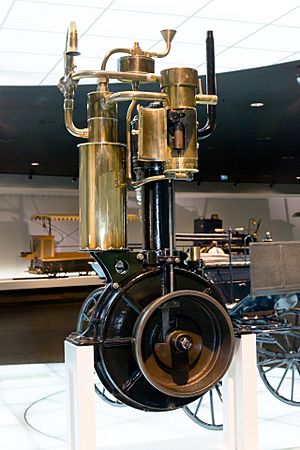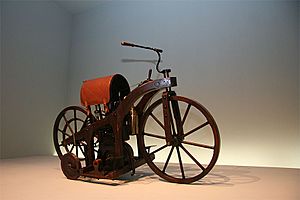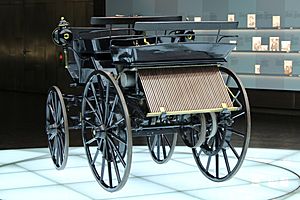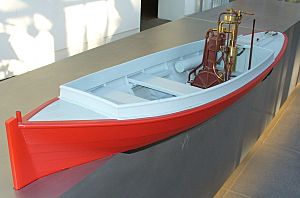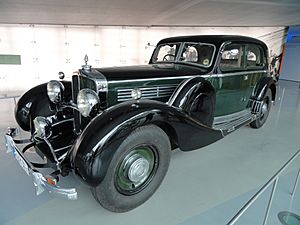Wilhelm Maybach facts for kids
Quick facts for kids
Wilhelm Maybach
|
|
|---|---|
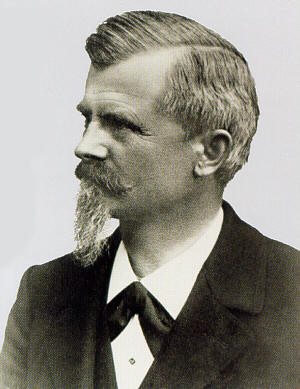
Wilhelm Maybach in 1900
|
|
| Born | 9 February 1846 |
| Died | 29 December 1929 (aged 83) |
| Nationality | German |
| Occupation | Engineer and industrialist |
| Known for | Daimler Motoren Gesellschaft, Maybach-Motorenbau GmbH |
Wilhelm Maybach (German: [ˈvɪlhɛlm ˈmaɪbax]; born February 9, 1846 – died December 29, 1929) was an important German engineer and businessman. He helped design some of the very first engines and cars. In the 1890s, people in France, which was a big center for car making, called him the "King of Designers."
Wilhelm Maybach worked closely with Gottlieb Daimler in the late 1800s. They created small, fast engines that could power things on land, water, and in the air. These engines were used in the world's first motorcycle and motorboat. After Daimler passed away, Maybach helped create a new car model in 1902 called the Mercedes. This car was built to the ideas of Emil Jellinek.
Maybach became the technical director at Daimler Motoren Gesellschaft (DMG). But he didn't get along with the company's leaders. So, in 1907, Maybach left DMG. In 1909, he started his own company, Maybach-Motorenbau GmbH, with his son Karl. They first built engines for Zeppelin airships. After World War I, the company began making large, fancy cars called "Maybach." Wilhelm Maybach died in 1929, and his son Karl Maybach took over the business. Later, from about 1936, Maybach-Motorenbau designed and made almost all the engines for German tanks and military vehicles used in World War II.
After the war, Maybach Motorenbau continued to make diesel engines. In the 1960s, the company became part of Daimler-Benz and changed its name to MTU Friedrichshafen. The "Maybach" car brand was brought back in 2002 for very luxurious cars, but it wasn't very successful. In 2014, Daimler started making an extra-fancy version of the Mercedes-Benz S-Class under the new Mercedes-Maybach brand.
Contents
- Early Life and First Steps in Engineering (1846-1869)
- Working with Daimler and Otto (1869-1880)
- Daimler Motors: Creating Fast, Small Engines (1882)
- The First Daimler-Maybach Automobile (1889)
- Daimler Motoren Gesellschaft (DMG) and the Phoenix Engine (1890-1900)
- The Daimler-Mercedes Engine of 1900
- Engines for Zeppelin Airships (1908)
- Maybach Automobiles (1922-1945)
- Maybach Motorenbau GmbH After Wilhelm Maybach
- Maybach's Lasting Impact
- See also
Early Life and First Steps in Engineering (1846-1869)
Wilhelm Maybach was born in Heilbronn, Germany, in 1846. His father was a carpenter. When Wilhelm was eight, his family moved to Stuttgart. Sadly, his mother died in 1856, and his father died in 1859.
After his relatives put an ad in a newspaper, a kind organization in Reutlingen took Maybach in as a student. The head of this organization, Gustav Werner, saw that Maybach was very good with machines. He helped Maybach start a career by sending him to the school's engineering workshop. By the time he was 15 (in 1861), Maybach was planning a career in Industrial design. He took extra classes in physics and math.
When he was 19, Maybach was a skilled designer working on engines that stayed in one place. His boss, Gottlieb Daimler, who was 29, noticed how hard Maybach worked. Daimler made him his main helper. Maybach kept this job until Daimler passed away in 1900.
Working with Daimler and Otto (1869-1880)
In 1869, Maybach followed Daimler to a company in Karlsruhe that made large trains. Daimler was on the main committee there. They spent many nights talking about new ideas for engines, pumps, and other machines.
In 1872, Daimler moved to Deutz-AG-Gasmotorenfabrik in Cologne. This was the world's biggest maker of stationary gas engines at the time. Nicolaus Otto, who partly owned the company, worked with Daimler on engine development. Maybach joined them as the main designer.
In 1876, Nicolaus Otto patented the Otto cycle engine. This was a four-stroke gas engine. It worked in four steps: intake, compression, power, and exhaust. One of Otto's patents for this engine was later canceled. This allowed Daimler and Maybach to create their own high-speed engine.
Also in 1876, Maybach went to the Philadelphia World's Fair in the USA to show Deutz's engines. When he returned to Cologne in 1877, he focused on making the four-stroke engine better. He wanted it ready for sale.
In 1878, Maybach married Bertha Wilhelmine Habermaas. She was a friend of Daimler's wife. On July 6, 1879, their first child, Karl Maybach, was born. They had three children in total.
In 1880, Daimler and Otto had big disagreements. Daimler left Deutz-AG. He received a lot of money from the company for patents he and Maybach had been granted. Maybach also left soon after. He followed his friend to start a new company in Cannstatt.
Daimler Motors: Creating Fast, Small Engines (1882)
In 1882, Maybach moved to Cannstatt, a part of Stuttgart. Daimler had bought a house there. They added a brick room to the glass summer house in the garden. This became their workshop.
Their work made the neighbors worried. They thought Daimler and Maybach were making fake money! The police even searched their property when they were away. But the police only found engines.
The Daimler Engine
In late 1883, Daimler and Maybach patented their first engine that used Ligroin fuel. This engine was patented on December 16, 1883. It met Daimler's goal of being small and running fast. It could reach 750 rpm (revolutions per minute), and soon up to 900 rpm. Daimler had three of these engines built in 1884. Maybach convinced him to put one in a vehicle. This led to the Reitwagen.
In 1884, Maybach's second son, Adolf, was born.
The "Grandfather Clock Engine" (1885)
By the end of 1885, Maybach and Daimler created an engine that is seen as the start of all modern petrol engines. It had:
- a single vertical cylinder
- air cooling
- a large cast-iron flywheel
- a new hot tube ignition system (Patent 28022)
- an exhaust valve controlled by a camshaft, which allowed high speeds.
This engine could reach 600 rpm. At that time, most engines could only do about 120 to 180 rpm.
In 1885, they also created the first carburetor. This device mixed evaporated gasoline with air. This made the fuel work much better. They used it that year on a larger, but still small, version of the engine. This engine had:
- 1 Horsepower at 600 rpm
- 100 cc engine displacement
- an uncooled cylinder with a hot-tube ignition (patent DRP-28-022)
Daimler called it the Standuhr, which means "grandfather clock" in German. It looked like one.
In November 1885, Daimler put a smaller version of the engine onto a wooden bicycle. This created the first motorcycle (patent 36-423 – Vehicle with gas or petroleum engine). Maybach rode it three kilometers (about 1.8 miles) from Cannstatt to Untertürkheim. He reached a speed of 12 km/h (7.5 mph) (about 7.5 mph). This vehicle became known as the Reitwagen.
On March 8, 1886, the inventors bought an American coach. They told their neighbors it was a birthday gift for Mrs. Daimler. Maybach put a larger 1.5 hp Grandfather Clock engine into the coach. He also added a belt drive to the wheels. When tested on the road, the vehicle reached 15 km/h (9.3 mph) (about 9 mph).
Maybach and Daimler continued to test their engine in many ways:
- On water (1887): They put the engine in a 4.5-meter-long boat. It went 6 knots (about 11 km/h or 7 mph). The boat was named the Neckar after the river where it was tested. Motorboat engines became their main product for many years.
- More road vehicles: They also built other street cars.
- In the air: They built the first motorized airship. This was a balloon based on designs by Dr. Friedrich Hermann Wölfert. They replaced his hand-powered system and successfully flew over Seelberg on August 10, 1888.
By 1887, they started selling licenses for their patents in other countries. Maybach represented the company at the big Paris Exposition Universelle (1889).
The First Daimler-Maybach Automobile (1889)
| · high speed four-stroke petrol engine |
| · fuel vaporization |
| · 2 cylinders V-configured |
| · mushroom shaped valves |
| · water-cooled |
| · 4-speed toothed gearbox |
| · pioneer axle-pivot steering system |
Sales of their engines grew, especially for the Neckar motorboat. In June 1887, Daimler bought land in the Seelberg Hills of Cannstatt. The workshop was a bit far from the town because Cannstatt's mayor didn't want the workshop in the town itself. It was a large area and cost a lot of money. They first hired 23 people. Daimler handled the business side, and Maybach managed the design work.
In 1889, they built their first car that was designed as a car from the start. It wasn't just a modified coach. Both inventors showed it to the public in Paris in October 1889.
Daimler's engine licenses started to be used all over the world. This began the modern car industry in many countries:
- France, 1890, Panhard & Levassor and Peugeot
- United Kingdom, 1896, The Daimler Motor Company of Coventry
- United States of America, 1891, Steinway
- Austro-Daimler in Austria, starting in 1899
Daimler Motoren Gesellschaft (DMG) and the Phoenix Engine (1890-1900)
The company needed more money to keep going. Selling engines and patents wasn't bringing in enough. New investors, Max von Duttenhofer and William Lorenz, joined. They were connected to Kilian von Steiner, a German investment banker. The company then became public.
In 1890, Daimler and Maybach officially started the Daimler Motoren Gesellschaft (DMG). This company was focused on building small, fast engines for land, water, or air travel. Maybach was the Chief Designer. They spent a long time deciding which fuel was best for Otto's four-stroke engine. It usually used methane gas. They decided to use petroleum, which until then was mostly used as a cleaner and sold in pharmacies.
The company officially started on November 28, 1890. Some historians call this a "deal with the devil" because the next ten years were difficult for Daimler and Maybach. DMG kept growing, selling engines from Moscow to New York. They added more ways to make stationary engines. But many still believed that making cars would not make money. The new leaders wanted to combine DMG and Deutz-AG, even though Daimler disagreed with Nicolaus Otto.
Gottlieb Daimler and Chief Engineer Maybach wanted to make cars. They disagreed with Duttenhofer and Lorenz. Maybach was not allowed to be on the Board of Management. So, he left the company on February 11, 1891. He continued his design work from his own house, with money from Daimler. In late 1892, he set up a workshop in a hotel ballroom. He hired 17 workers, and Daimler paid five of them.
In 1894, Maybach designed his third engine model with Daimler and his son Paul. This engine, used in the Phoenix car, became famous worldwide. It was one of the first to use four cylinders in a car. It also had:
- cylinders cast together in one block, placed vertically
- exhaust valves controlled by a camshaft
- a spray-nozzle carburetor (patented by Maybach in 1893)
- an improved belt drive
Maybach's inventions are seen as some of the best engines of the late 1800s. His ideas became essential for carmakers everywhere. He was known as the main force behind France's early car industry, where he was called the "King of Designers."
Daimler was forced out of his job as Technical Director at DMG and quit in 1893. This hurt DMG's reputation. However, in 1894, a British businessman, Frederick Simms, bought the rights to the Phoenix engine for a lot of money. This helped DMG's finances. He also made it a condition that Daimler be hired back. In 1895, DMG built its 1,000th engine. Maybach also returned as Chief Engineer. He received shares in the company because of his original agreement with Gottlieb Daimler.
Maybach patented more car inventions, including:
- a new cooling system, a tubular radiator with a fan
- the honeycomb radiator
Around this time, Maybach faced two sad events. His teenage second son, Adolf, became very ill and spent the rest of his life in hospitals. (Later, in 1940, his son died during a difficult time in Germany.) In 1900, Gottlieb Daimler died from heart disease.
The Daimler-Mercedes Engine of 1900
| · Large wheelbase. Wide track |
| · Pressed steel framework. Lightweight metals |
| · Low center of gravity (lower engine) |
| · 75 km/h (45 mph). 35 hp (950 rpm) · 300 to 1000 rpm (driver controlled) |
| · Light and high-performance engine: 4 in-line cylinders · Bore/stroke ratio: 116x140 mm · Displacement: 5918 cc · Cylinder heads part of the castings · Two carburetors, one for each cylinder pair · Driver controlled intake valve throttling · Two camshafts |
| · 4-forward/1-reverse transmission |
| · Low voltage ignition magnetos |
| · Aluminium crankcase (pioneer), horizontally divided |
| · Honeycomb radiator |
| · Comfortable ride |
Between April and October 1900, Maybach designed a completely new type of car. It was inspired by racing cars. This car would be called the Mercedes 35 hp when it was released in 1902. It had:
- a long distance between the front and back wheels
- a wide track (distance between the left and right wheels)
- a low height
- amazing power from its 35 hp engine, letting it reach 75 km/h (47 mph) (about 47 mph).
Emil Jellinek was a successful Austrian car dealer and racing driver. He greatly admired Maybach's work. Jellinek promised to buy 36 cars for a large sum of money if Maybach could design a great race car for him based on his ideas.
The first version of the car was finished in December 1900. In 1901, it won many races. Its engine was named Daimler-Mercedes. "Mercedes" means "mercy" in Spanish and was the name of Emil Jellinek's 10-year-old daughter. Rich people in Europe bought the car in large numbers. This made it a big commercial success. It convinced the company leaders that cars had a future. Production grew a lot, and DMG quickly became much larger. DMG officially registered the Mercedes trademark in June 1902.
In 1902, a fire destroyed DMG's facilities in Cannstatt. The company moved to Stuttgart-Untertürkheim. Maybach kept creating new things:
- a 6-cylinder/70 hp engine (1903–04)
- a pioneering aircraft engine: a high-speed racing engine of 120 hp, with special valves and double ignition (1906)
DMG moved him to an "Inventor's Office." This made him leave the company again in 1907. DMG replaced him with Paul Daimler. That same year, the German Engineers Association (VDI) made Wilhelm Maybach an honorary member.
Engines for Zeppelin Airships (1908)
In 1900, Maybach first met Count Ferdinand von Zeppelin. The Count wanted to make the engines of his Zeppelin LZ1 airship better. Maybach built some engines for him. These were based on designs for a 150 hp engine created by his son, Karl, while Karl was at DMG.
In 1908, Count Zeppelin tried to sell his LZ3 and LZ4 airships to the government. On August 5, the LZ4 exploded after trying an emergency landing because its engines failed. This was not the end for the airship project. People donated a huge amount of money after the accident. Count Zeppelin then founded the Luftschiffbau Zeppelin GmbH, the company that built the Zeppelin airships.
Maybach had to wait a bit to join the new company because he was still in a legal fight with DMG. So, Karl took his place. On March 23, 1909, a deal was finally signed. This created an engine company that was part of Luftschiffbau Zeppelin. It was located in Bissingen/Enz. Wilhelm Maybach was the Technical Assistant, and Karl was the Technical Manager. Their first engine designs allowed airships to reach 72 km/h (45 mph) (about 45 mph).
Wilhelm Maybach moved his company to Friedrichshafen and renamed it Luftfahrzeug-Motoren-GmbH. Karl and Wilhelm owned 20% of the company, with Karl set to inherit it. They kept supplying engines to Zeppelin, but also worked on engines for other airships. In 1912, the company changed its name to Maybach-Motorenbau GmbH (Maybach Engine Construction Company). In 1916, they developed a 160 hp aircraft engine. They sold 2000 of these before World War I ended. In 1916, Wilhelm Maybach received an honorary doctorate from the Technical University of Stuttgart.
Maybach Automobiles (1922-1945)
After World War I, the Versailles Treaty of 1919 stopped Germany from making airships. So, Maybach started making fast diesel engines for ships and trains. He also made petrol engines for cars, but not complete cars at first.
Many small carmakers in Germany built their own engines to save money. Only the Dutch Spyker company was interested in buying Maybach engines. Wilhelm Maybach turned down their offer because he couldn't agree to their terms. Instead, he decided to build complete cars. The factory began producing Maybach luxury cars in 1921.
The first model, the Maybach W3, was shown at the 1921 Automobile Exposition in Berlin. It had:
- a 6-cylinder engine
- brakes on all 4 wheels
- a new transmission system
- a top speed of 105 km/h (65 mph) (about 65 mph)
This model was made until 1928, selling 300 units. Most were sedans; the two-seat sport version was less popular. The Maybach W5 came next. Its top speed increased to 135 km/h (84 mph) (about 84 mph). They sold 250 units in 1927 and 1929.
Next, Maybach produced the V12 car. This was the first 12-cylinder German car. It had:
- a lightweight aluminum engine, based on his airship work
- light alloy pistons
- a 7-liter capacity
- high power – 150 hp (110 kW) at 2,800 rpm
Only a few dozen were sold because of Germany's economic problems after the war. In 1930, its next version, the DS7-Zeppelin, also had a 12-cylinder, 7-liter engine.
In August 1929, the Zeppelin LZ-127 used five Maybach-V12 petrol engines, each with 550 hp (410 kW).
Neither Wilhelm nor Karl Maybach ever owned a Maybach car. Wilhelm never even owned any car. He created the basics for modern cars, but he rarely used one himself. He preferred to walk or take the tram. Even though he could have afforded a car, he didn't own one.
Wilhelm Maybach died at 83 years old in Stuttgart on December 29, 1929.
Maybach Motorenbau GmbH After Wilhelm Maybach
His company, Maybach Motorenbau GmbH, continued in Friedrichshafen under his son Karl Maybach. From about 1935, Maybach designed and made almost all the engines for tanks and half-tracks used by the German military during World War II. After 1945, it made many types of diesel engines. In the early 1960s, Maybach started building large Daimler-Benz engines under a special agreement. This led to a close partnership with Daimler-Benz.
In the mid-1960s, Maybach Motorenbau GmbH became Maybach Mercedes-Benz Motorenbau GmbH. Daimler-Benz owned 83 percent of it.
In 1998, Mercedes-Benz announced they would bring back the Maybach brand for cars, but this was only for a short time. Today, Daimler AG makes a very luxurious version of the Mercedes-Benz S-Class under the Mercedes-Maybach brand.
Maybach's Lasting Impact
- Wilhelm Maybach was added to the Automotive Hall of Fame in 1996.
- Three technical schools in Germany are named Wilhelm Maybach: in Stuttgart, Heilbronn, and Berlin-Spandau.
- In 2002, Daimler AG started making cars under the Maybach name again.
- In 2005, Ulrich Schmid-Maybach started the Wilhelm and Karl Maybach Foundation. He did this to honor his grandfather Karl and great-grandfather Wilhelm.
See also
 In Spanish: Wilhelm Maybach para niños
In Spanish: Wilhelm Maybach para niños
- Mercedes Simplex
- Mercedes-Benz
- German inventors and discoverers



